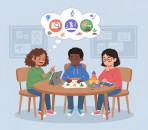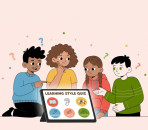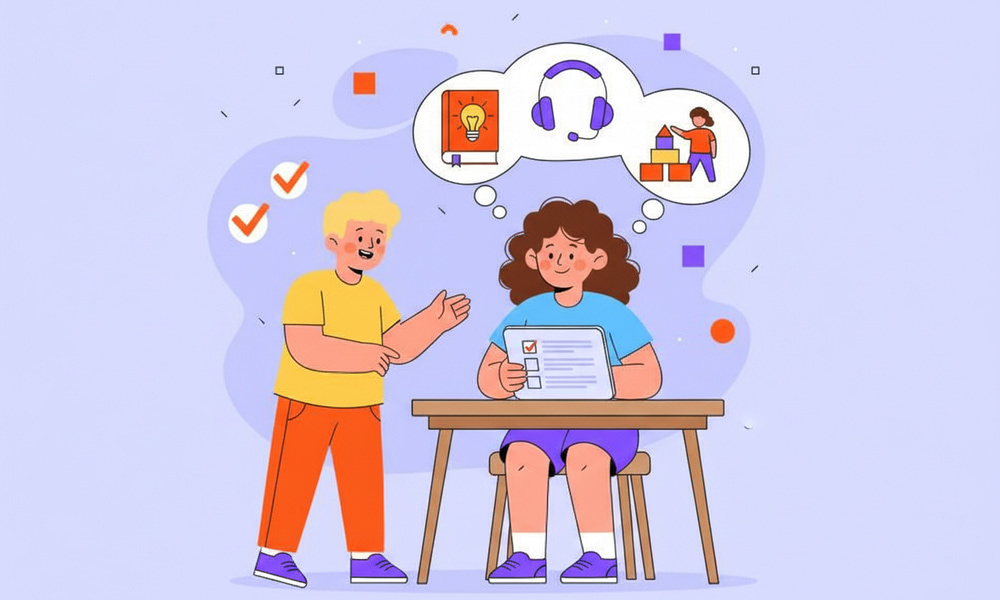Your Learning Styles Quiz for Kids & Students
New Updates



What Type of Learning Style I Have?
Get StartedVisual, Auditory, or Kinesthetic? Unlock Your Learning Type Now!
Every child brings a unique blend of strengths, motivations, and sensory preferences to the classroom, and those ingredients shape how knowledge sticks. When parents and teachers decode those patterns, they can design instruction that amplifies curiosity and reduces frustration. That shift improves focus, builds confidence, and helps learners connect new ideas to what they already know in meaningful ways. In turn, homework becomes less about grinding and more about growth. Families often ask how to begin translating observations into action without oversimplifying a child’s abilities. Many discover that a learning style quiz for kids resource clarifies classroom struggles without labeling children. Rather than pigeonholing, a good assessment offers a starting map, showing which combinations of input and practice make schoolwork feel natural. With that map in hand, adults can pilot small, low-risk changes that compound over time.
Educators also look for a quick, research-aligned way to open conversations about preferences during the first weeks of school. Some programs start with a short learning style quiz to spark reflection and create a shared vocabulary around strengths. When students hear their own strategies validated, they tend to participate more, ask better questions, and self-advocate with clarity. That shared language sets the stage for targeted support and feedback. Parents who support study routines at home often need a simple diagnostic that fits busy schedules. Before diving into homework, a short study quiz can prime attention and build metacognitive awareness. By highlighting how a child organizes information, such warm‑ups guide choices like where to sit, which materials to prepare, and how to break tasks into manageable chunks. Small adjustments in the first five minutes frequently pay off across the entire evening.

Key Benefits of Using Learning Styles Inventory Quiz
Thoughtful use of preference assessments can reduce guesswork in lesson planning and after‑school routines. Caregivers gain insight into the sensory channels that help each child encode, store, and retrieve information. Students gain a sense of agency as they experiment with techniques that match how their brains like to process input. This collaborative approach turns friction into feedback, which steadily improves outcomes. Many schools pair general preference tools with frameworks that broaden the conversation beyond modalities. When teachers want to capture strengths like spatial reasoning, rhythm, or interpersonal savvy, they sometimes introduce a multiple intelligences quiz that spotlights these capacities. Highlighting non‑traditional talents encourages children to bring their whole selves to class activities. That recognition can be transformative for learners who have felt unseen.
Parents frequently ask for activities that translate profiles into everyday tactics students can use immediately. Some families journal reflections guided by prompts from a what my learning style quiz, then test new approaches during reading or math practice. As learners connect strategy with results, they build a toolbox of methods that feel natural rather than forced. Over time, those tactics become habits that travel from class to class. Classrooms benefit when teachers can differentiate without reinventing the entire syllabus. Many instructors adapt note‑taking, discussion formats, and practice cycles after reviewing patterns revealed by a learning style quiz for students. Simple changes, like adding sketchnotes, whisper reading corners, or quick whiteboard sprints, support varied preferences without disrupting pacing. The result is a learning environment where more children can flourish simultaneously.
- Boosts engagement by matching inputs to attention patterns.
- Strengthens memory through personalized encoding strategies.
- Encourages self‑advocacy and reflective learning habits.
- Guides differentiation without excessive workload.
- Builds positive mindsets through visible progress.
Make Sense of Your Multiple Intelligences Quiz Results
Not all assessments aim at the same target, so clarity about purpose is essential before choosing a tool. Some instruments emphasize sensory channels, while others emphasize broader abilities, learning cycles, or study behaviors. By aligning the tool with your goal, study efficiency, classroom differentiation, or talent discovery, you avoid mismatched expectations and misinterpretations that can derail momentum.
Caregivers often explore identity‑building prompts to help kids describe how they like to explore new topics. During these reflective conversations, a student might experiment with prompts inspired by a what type of learner am i quiz to articulate preferences in plain language. When children can narrate what works for them, teachers can translate those insights into flexible options. The dialogue also normalizes trying new strategies and iterating on what sticks.
| Approach | Primary Focus | Best For | Typical Outputs |
|---|---|---|---|
| Modalities (e.g., visual, auditory, kinesthetic) | Preferred input channels and expression modes | Optimizing note‑taking, explanations, and practice choices | Modality mix, study suggestions, classroom accommodations |
| Strengths frameworks | Broader abilities like spatial, musical, interpersonal | Project design, group roles, and talent development | Strength profiles, enrichment ideas, feedback language |
| Learning cycles | How learners move from exposure to application | Sequencing lessons, review timing, and assessment design | Cycle stage preferences, pacing plans, reflection prompts |
| Study behaviors | Habits such as spacing, retrieval, and organization | Homework routines, test prep, and time management | Action checklists, habit trackers, and environment tweaks |
Schools that scaffold reflection through planners and goal‑setting templates often see faster adoption of new habits. Some districts incorporate profiles and weekly check‑ins modeled after an education planner learning style quiz so that students track which strategies yield results. With regular reflection, learners adjust proactively before grades slide. That rhythm builds resilience and a growth mindset anchored in data.
Families working outside formal programs appreciate tools that are easy to access and simple to explain. Weekend routines sometimes begin with a free learning style quiz to surface preferences and seed a conversation about upcoming assignments. The results guide practical decisions like creating a quiet corner, preparing manipulatives, or selecting multimedia resources. Over time, those routines become a shared language for tackling tough tasks together.
- Define your goal before choosing a tool.
- Use results to suggest options, not impose limits.
- Pilot one change at a time and measure its impact.
- Revisit profiles each term to capture growth.

Learning Type Quiz: A Practical Roadmap for Parents and Teachers
Start with observation, looking for patterns in energy, focus, and persistence across different types of work. Note when a child lights up, stalls out, or asks for help, and record the context so you can test hypotheses later. Use those notes to choose a lightweight assessment that links directly to actions you can try this week.
After you gather initial reflections, many families capture preferences in a one‑page profile and revisit it monthly. When that profile feels incomplete, some caregivers add prompts based on a finding your learning style quiz to make strengths and needs more concrete. With clarity in place, aim for small experiments, change the study space, tweak the order of tasks, or modify how information is presented. Then track what works in a simple checklist.
- Pick one subject to pilot new strategies for two weeks.
- Introduce retrieval practice using short, daily recall bursts.
- Alternate formats: diagrams, read‑alouds, hands‑on models.
- Space review sessions and set micro‑goals for each.
- Close with reflection: what helped, what to adjust, and why.
Teachers can weave preference‑informed options into routines without fragmenting lessons. In some cases, advisory periods include adult‑guided reflections inspired by a learning style quiz for adults to model metacognition for students. When teachers share their own profiles and strategies, they normalize experimentation and productive struggle. That modeling strengthens classroom culture and mutual trust. As strategies consolidate, families can expand beyond modalities to the habits that drive long‑term retention and transfer. Some learners anchor their toolbox by naming patterns surfaced in a learning type quiz and pairing them with proven study methods like spacing and interleaving. The key is to keep the system simple, visible, and flexible so it evolves with the child. Consistency beats intensity when building durable habits.
What Type of Learning Style I Have?
Get StartedFrequently Asked Questions
-
Are learning style assessments scientifically valid for every decision?
They are helpful when used as conversation starters and planning aids rather than hard labels. In practice, triangulating profile insights with performance data and student feedback yields the best guidance for instruction. Some schools also blend preference data with curriculum goals to keep the focus on mastery and growth across subjects.
-
How do I turn results into daily study strategies?
Translate each insight into one small, testable action connected to a specific task, then measure the result. For families who like structured prompts, a reflection drawn from a types of learning styles quiz can map each preference to two or three concrete techniques. Keep a weekly scorecard so the child can see which tactics move the needle, and retire those that do not help. Over time, the routine becomes automatic and less effortful.
-
Can these tools reduce test anxiety for children?
Yes, because clarity about what works lowers uncertainty and gives students a plan they trust. During pre‑exam weeks, some learners practice recall using prompts informed by a how do I learn best quiz to align review sessions with personal strengths. Pair those sessions with sleep, movement, and brief breaks to prevent cognitive overload. Confidence tends to rise when preparation feels tailored and predictable.
-
What should teachers do if results seem contradictory?
Treat profiles as snapshots that require verification in real tasks and over time. When patterns conflict, look for the context, subject matter, assignment complexity, and social setting before concluding and then run small pilots to see what sticks. Classrooms can host choice menus so that multiple routes to mastery coexist without disrupting pacing or fairness.
-
How can schools integrate these insights at scale?
Start with common reflection protocols, shared language, and lightweight documentation that fit existing workflows. Professional learning communities can model strategies and review examples linked to a VARK learning style quiz to ensure options cover multiple input and output modes. As teams gather evidence of impact, they can refine templates and build a library of tactics aligned to course goals. Sustainable systems emerge when changes are incremental and teacher‑driven.
 The Ultimate Guide to Skill-Mapping Through Multiple Intelligences
The Ultimate Guide to Skill-Mapping Through Multiple Intelligences